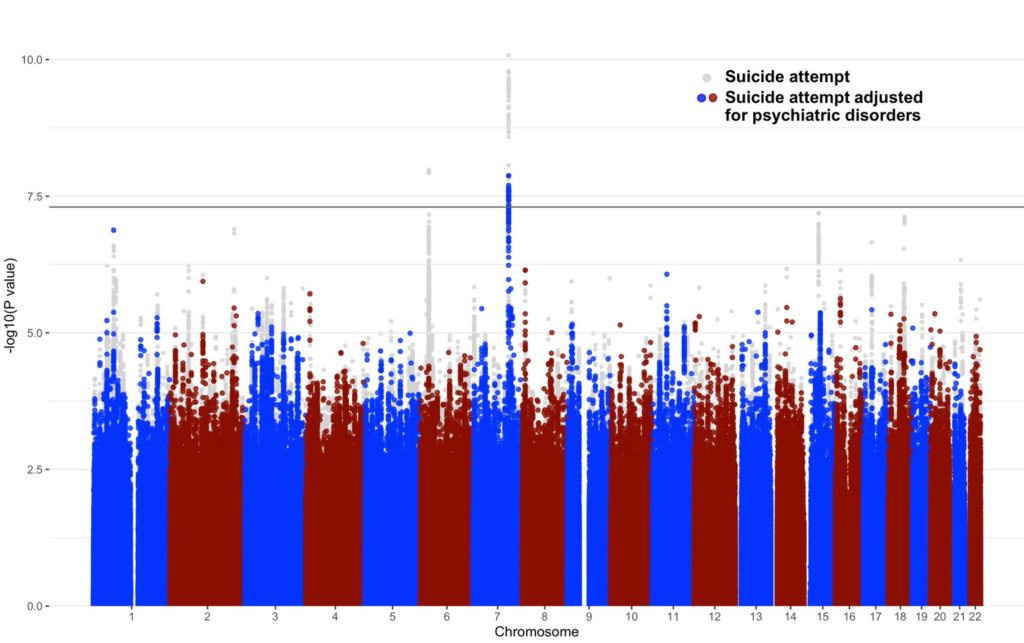The findings, published today in the journal Biological Psychiatry, imply that the genetic roots of suicide attempts are both common and distinct from those of related psychiatric diseases.
In the largest genetic analysis of suicide attempts to date, experts have discovered an area of the genome on chromosome 7 that contains DNA variations that raise the risk of attempting suicide.
The study also indicated a genetic overlap between suicide attempts and related psychiatric diseases, particularly major depression, as well as between suicide attempts and non-psychiatric risk factors such as smoking, risk-taking behavior, sleep difficulties, and poorer overall health.
The findings, which were published in the journal Biological Psychiatry on November 30, imply that the genetic roots of suicide attempts are both common and distinct from those of related psychiatric diseases.
Suicide is a global public health issue that results in almost 800,000 deaths each year. Nonfatal suicide attempts are estimated to occur more than 20 times for every suicide fatality, and they are a significant cause of disability, diminished quality of life, and social and economic cost. Suicidal thoughts and behaviors can be decreased with the right mental health care.
As a result, it’s critical to study more about the underlying biochemical pathways that lead to suicide attempts or thoughts, as this information could lead to new treatment and preventive options.
To study this, An international team of experts from the International Suicide Genetics Consortium ran a genome-wide association analysis to better understand the underlying biology of suicide attempts. This strategy entails screening the DNA of a large number of people in order to find genetic markers that were more common in those who attempted suicide. The researchers looked at almost 7.5 million common changes in the DNA sequences of nearly 550,000 persons, nearly 30,000 of whom had attempted suicide.
“In addition to identifying the risk location for suicide attempt on chromosome 7, we uncovered a strong overlap in the genetic basis of suicide attempt and that of psychiatric disorders, particularly major depression, as well as some overlap with the genetics of smoking, pain, risk-taking, sleep disturbances, and poorer general health,” says Niamh Mullins, the lead author of the paper.

“This genetic overlap with non-psychiatric risk factors was largely unchanged by adjusting for psychiatric disorders, which suggests that a substantial component of the biological basis of suicide attempt is not simply a byproduct of comorbid psychiatric disease, but instead may be the result of shared biology with non-psychiatric risk factors.”
An independent analysis of more than 14,000 veterans who had attempted suicide from the Million Veterans Program, a national research program to learn how genes, lifestyle, and military exposures affect health and illness, found that the link between genetic variations on chromosome 7 and the risk of attempting suicide was not mediated by comorbid psychiatric disorders.
“This study is an exciting advancement of our understanding of how the genetics of suicide attempt relate to that of psychiatric and non-psychiatric risk factors,” says JooEun Kang, the co-lead author of this paper.
Previous study has connected DNA variations in this region to insomnia, smoking, and risk-taking behavior, and while more research is needed to unravel the underlying biological mechanism, studies like this help researchers have a better grasp of the neurobiology of suicidality.
“The study findings also point to the importance of studying the potential direct causal paths between these risk factors and suicide attempt in patients with and without psychiatric illness,” adds Douglas Ruderfer, co-founder and co-chair of the consortium, and senior author of the paper.
If you are in crisis, please call the National Suicide Prevention 24-hour Lifeline at 1-800-273-TALK (8255), or contact the Crisis Text Line by texting TALK to 741741, or visit their website at: http://suicidepreventionlifeline.org.
Source: THE MOUNT SINAI HOSPITAL / MOUNT SINAI SCHOOL OF MEDICINE
Image Credit: iStock
You were reading: This part of DNA increases the risk that a person will attempt suicide
